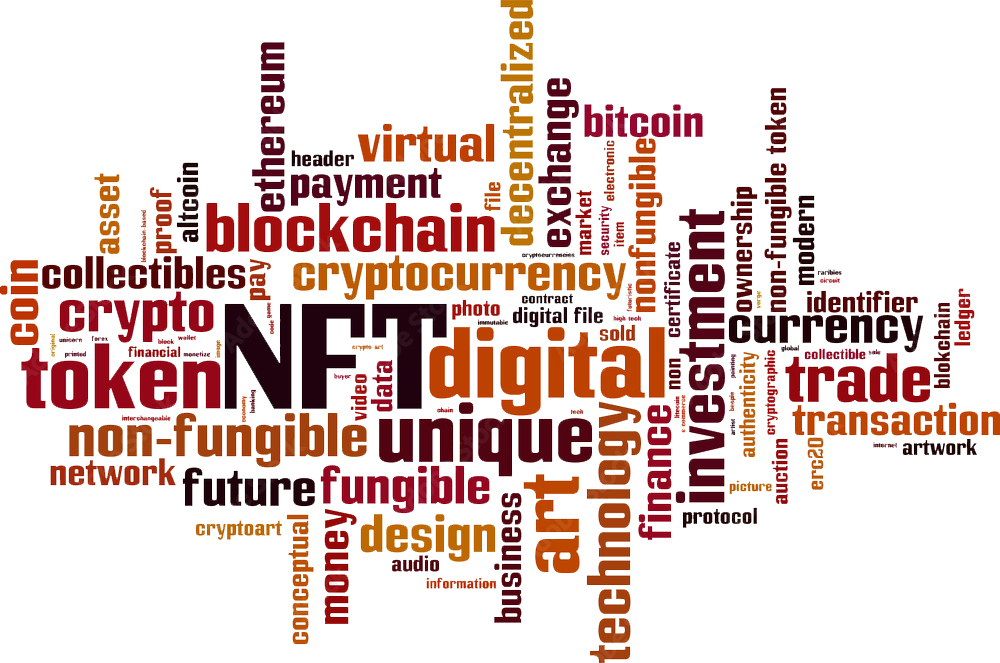A list of some of the most-used words
In the NFT space, certain terms and phrases have become common. Here’s a list of some of the most-used words and their meanings:

1. NFT (Non-Fungible Token):
- Meaning: A unique digital asset verified using blockchain technology. Unlike cryptocurrencies like Bitcoin or Ethereum, NFTs are not interchangeable on a one-to-one basis (i.e., non-fungible). Each NFT represents ownership of a unique item, such as artwork, music, or a collectible.
2. Blockchain:
- Meaning: A decentralized digital ledger that records transactions across many computers in a way that the records can’t be altered retroactively. Ethereum and Solana are popular blockchains used for NFTs.
3. Minting:
- Meaning: The process of turning a digital file (like an image, music, or video) into an NFT by recording it on the blockchain. Once minted, it becomes a permanent part of the blockchain and can be bought, sold, or traded.
4. Smart Contract:
- Meaning: Self-executing code on a blockchain that automates transactions and the conditions tied to them. Smart contracts are used in NFTs to govern how ownership is transferred or royalties are paid.
5. Gas Fees:
- Meaning: The fee paid to the blockchain network to process transactions, such as minting or transferring NFTs. Gas fees are particularly high on Ethereum but can vary depending on network congestion.
6. Metadata:
- Meaning: The information embedded within an NFT that describes its properties, such as its creator, the file it represents, and any associated attributes or traits.
7. Floor Price:
- Meaning: The lowest price at which an NFT in a particular collection is currently listed for sale. It’s an important indicator of a collection’s value and market activity.
8. Rarity:
- Meaning: How uncommon certain traits or characteristics of an NFT are compared to others in a collection. Rarer NFTs are often seen as more valuable.
9. DAO (Decentralized Autonomous Organization):
- Meaning: A community-led organization governed by rules encoded in smart contracts. DAOs are becoming popular in the NFT space for making decisions collectively, such as how funds are used or which projects to support.
10. Airdrop:
- Meaning: The free distribution of NFTs or tokens to holders of certain assets or participants in an event. Airdrops are often used to reward early adopters or members of an NFT community.
11. Rug Pull:
- Meaning: A scam in which developers of an NFT project suddenly abandon it after collecting funds, leaving the project without future development or value.
12. Whitelisting:
- Meaning: The process of pre-approving users to participate in an NFT sale, usually at a discounted or early-access price. Those on the whitelist are guaranteed a chance to buy NFTs before the public.
13. Burn:
- Meaning: The process of permanently removing an NFT from circulation by sending it to a verifiable unspendable address. This can be done to reduce supply or remove undesirable assets.
14. PFP (Profile Picture):
- Meaning: A category of NFTs used as social media avatars. Popular PFP collections include projects like CryptoPunks and Bored Ape Yacht Club. PFPs have a mix of collectible and identity-related appeal.
15. Utility:
- Meaning: The additional value or benefits an NFT provides beyond ownership of the digital asset. This could include access to events, membership in a community, or future rewards and airdrops.
16. Metaverse:
- Meaning: A virtual world where NFTs can be used to own land, avatars, items, or other digital assets. Metaverse platforms like Decentraland and The Sandbox are integrating NFTs as part of their ecosystems.
17. Royalties:
- Meaning: A percentage of sales that the creator of an NFT can receive each time the NFT is resold. This allows artists and creators to continue earning from secondary market transactions.
18. DeFi (Decentralized Finance):
- Meaning: A financial ecosystem built on blockchain technology that allows people to trade, lend, and borrow assets without intermediaries. NFTs can sometimes be used as collateral in DeFi platforms.
19. OpenSea:
- Meaning: One of the largest NFT marketplaces where users can create, buy, sell, and trade NFTs. Other popular marketplaces include Rarible and Foundation.
20. Staking:
- Meaning: A process where NFT holders lock their NFTs into a platform to earn rewards, such as additional tokens or exclusive content.
21. Mint Pass:
- Meaning: An NFT that grants the holder the right to mint another NFT, typically from a future collection. These are often used to reward early supporters.
22. Tokenomics:
- Meaning: The economic model behind a token or NFT project, detailing how tokens are distributed, used, and incentivized. Good tokenomics helps build a sustainable ecosystem around the NFT project.
23. Rugged:
- Meaning: Slang for being a victim of a rug pull, where a project fails or is abandoned, leading to a loss of value in the NFT or token.
24. Snapshot:
- Meaning: A moment in time where ownership of NFTs or tokens is recorded. Snapshots are used to distribute rewards, such as airdrops, based on who holds certain assets at a specific time.
25. Fractionalization:
- Meaning: The process of breaking an NFT into smaller parts (fractions) so multiple people can own a share of a single NFT, allowing for joint ownership and liquidity.
26. DYOR (Do Your Own Research):
- Meaning: A phrase commonly used in the crypto and NFT space to remind people to thoroughly research projects before investing, rather than relying solely on the opinions of others.
27. HODL (Hold On for Dear Life):
- Meaning: A term used to indicate holding onto an NFT or cryptocurrency long-term, regardless of market fluctuations. It originated from a misspelling of “hold” in early Bitcoin forums.
28. Flipping:
- Meaning: The act of buying NFTs at a low price and quickly reselling them at a higher price to make a profit.
29. WAGMI (We’re All Gonna Make It):
- Meaning: A positive, motivational phrase used by people in the NFT and crypto space to express optimism about the future success of the community.
30. NGMI (Not Gonna Make It):
- Meaning: A term used to describe someone who is making poor decisions or lacks belief in the long-term potential of NFTs, implying that they won’t succeed.
31. Pumping:
- Meaning: A rapid increase in the value of an NFT or cryptocurrency, often driven by market hype, influencer endorsements, or speculation.
32. Dumping:
- Meaning: The opposite of pumping, where an asset’s value rapidly decreases due to mass selling, sometimes triggered by panic or the end of a speculative bubble.
33. Shill:
- Meaning: Promoting or hyping an NFT project, often aggressively, to increase demand and drive up prices. Sometimes seen as insincere if the promoter is looking for personal gain.
34. Discord:
- Meaning: A popular platform for NFT communities where users chat in real time, share updates, and build community. Most NFT projects have a dedicated Discord server.
35. Rarity Score:
- Meaning: A numerical score assigned to an NFT based on the rarity of its traits or attributes. The higher the rarity score, the more unique and potentially valuable the NFT.
36. Whitelist Token:
- Meaning: A digital token that grants access to a presale or exclusive event within an NFT project, often used to reward early supporters or community members.
37. Generative Art:
- Meaning: Artwork created using algorithms or artificial intelligence, where each NFT is randomly generated with unique traits. Projects like CryptoPunks and Art Blocks are famous for generative art.
38. Mint Date:
- Meaning: The scheduled date and time when an NFT project will become available for minting. Being aware of the mint date is crucial for collectors wanting to get NFTs early.
39. Token Gated:
- Meaning: A feature where access to certain content, communities, or experiences is restricted to holders of a specific NFT or token.
40. Sweeping the Floor:
- Meaning: The act of buying up all the cheapest NFTs in a collection (the floor price NFTs), usually in bulk, to drive up the collection’s minimum price.
41. Derivative NFTs:
- Meaning: NFTs that are inspired by or based on other NFT projects, but typically created by different artists. While common, derivative projects can sometimes face legal challenges for copyright infringement.
42. ERC-721:
- Meaning: The most common NFT standard used on the Ethereum blockchain. It defines how NFTs should be created and behave on the network, allowing each token to be unique.
43. ERC-1155:
- Meaning: A token standard that allows both fungible and non-fungible tokens to be created under one contract, making it more efficient for creating large NFT collections.
44. Reveal:
- Meaning: When NFTs are minted, they often start with a placeholder image. The reveal is when the actual traits and appearance of the NFT are unveiled. This can drive market excitement as rarities are discovered.
45. Lazy Minting:
- Meaning: A method where NFTs are not minted on the blockchain until they are sold, saving creators upfront costs like gas fees until the NFT is purchased.
46. Bridging:
- Meaning: The process of moving assets, including NFTs, between different blockchains, such as from Ethereum to a sidechain like Polygon, often to save on transaction fees.
47. Liquidity:
- Meaning: How easily an NFT can be bought or sold in the market without affecting its price. Collections with high liquidity (many buyers and sellers) are easier to trade.
48. Metamask:
- Meaning: A popular cryptocurrency wallet and browser extension used to interact with decentralized applications (dApps) and NFT marketplaces. It allows users to store, buy, and sell NFTs.
49. Snapshot Voting:
- Meaning: A process where NFT or token holders participate in decentralized voting, typically related to governance or decision-making within a DAO or NFT project. A snapshot records eligible voters at a specific time.
50. IPFS (InterPlanetary File System):
- Meaning: A decentralized storage solution used to store the files (e.g., images, videos) linked to NFTs. Unlike traditional cloud storage, IPFS spreads data across a network of computers to ensure it remains accessible.
Understanding these terms will help you navigate the NFT space more effectively. These terms reflect the dynamic and fast-paced nature of the NFT ecosystem.

Leave a Reply